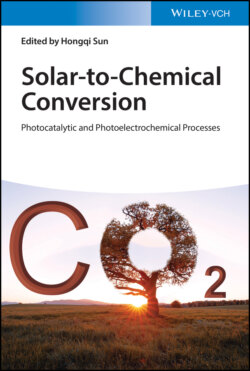Читать книгу Solar-to-Chemical Conversion - Группа авторов - Страница 31
3.1 Introduction
ОглавлениеConversion of sunlight into storable chemicals is a central and urgent challenge for modern science and technology. Its implications are not simply technological and economical: the outcome of this scientific endeavor can have historical significance, shaping the future of society and civilization on a global scale. The dire consequences of climate destabilization effected by the mounting use of fossil fuels are already amply manifested in extreme events and record‐breaking average temperatures year after year. Political responses against the inexorably evolving climate crisis and international coordination so far fall short of even meeting conservative stated targets, for example, on CO2 emissions. It is hoped that successful developments on a global scale [1] in the science and technology of capturing solar energy and storing it in chemical bonds, that is, the production of solar fuels, will aid in counterbalancing the use of coal, oil, and gas, potentially placing limits to future consequences of climate change.
It is an often‐repeated statement that the energy contained in just one hour of sunlight reaching the earth would be sufficient to cover a year's worth of our current global energy use. Regardless of the numerical preciseness of this statement, it gives an idea of the vast potential of sunlight as a renewable energy source. Harnessing solar energy can take several different forms. Conversion of sunlight to electricity and heat is already achievable, and application of relevant technologies should be distributed and maximized as much as possible. However, this type of solar energy utilization does not and cannot alone substitute for the use of fossil fuels [2], which account for the vast majority of global energy consumption. That is why the conversion of sunlight into fuels represents the ultimate goal. In attempting to reach it, we wish to replicate with our own technical means a crucial biological process, the process of natural photosynthesis.
Photosynthetic organisms appeared very early in the history of life on our planet. They use the energy of sunlight to drive their metabolism, producing reduced compounds that can be afterward oxidized to release the stored energy. Of particular interest to us is oxygenic photosynthesis, which is believed to have emerged around 2.5 billion years ago and marked the use of water as electron donor, with dioxygen as a by‐product. Oxygenic photosynthetic organisms today are plants, algae, and cyanobacteria. They oxidize water and reduce CO2 to carbohydrates. The splitting of water into dioxygen and hydrogen equivalents was a crucial turning point in the evolution of life [3]. Oxygenic photosynthesis is essentially the only source of atmospheric O2 on our planet. Surplus of photosynthetic biomass, i.e. organic products that were not oxidized soon after their formation (for example, through combustion or through respiration when used as food by other organisms; see Figure 3.1) but locked in the earth, led eventually to a surplus of dioxygen in the atmosphere. This generated the current atmospheric levels of O2 and the ozone layer, with all the implications for the emergence of complex multicellular life forms that exploit high‐energy oxidative metabolic pathways. Certain quantities of biomass that were not recycled into the food chain or oxidized by other means but instead buried in the earth happened to be transformed under special conditions and in geological time scales into coal, petroleum, and natural gas. Humans have always relied on and used the products of photosynthesis directly as food and fuel, while during the last two centuries we have also been using the indirect products of ancient photosynthesis, the fossil fuels.
Figure 3.1 The light‐dependent reactions of photosynthesis produce protons and electrons used in the conversion of CO2 to carbohydrates (CH2O) and other organic compounds, while oxidation of these organic compounds (biomass, food, fuels) by respiration or combustion releases the stored solar energy to power the metabolism of non‐photosynthetic organisms and drive human technologies.
In the present chapter the fundamental aspects, processes, and biomolecular systems of natural photosynthesis [4–8] are reviewed, with a brief discussion of corresponding artificial approaches that relate to solar fuels [9–18]. Artificial photosynthesis is an umbrella term that encompasses any kind of effort dedicated to replicating the fundamental conversion performed by natural photosynthesis. Here only selected biomimetic examples will be mentioned that draw direct inspiration from the natural system. A large variety of approaches for solar‐to‐chemical conversion will be extensively covered in subsequent chapters of this book.
